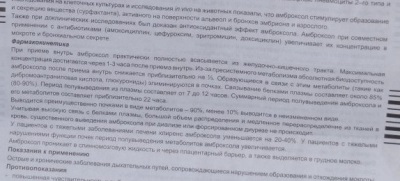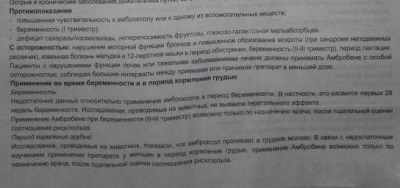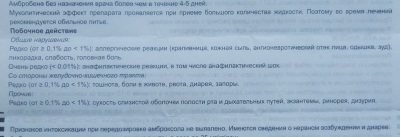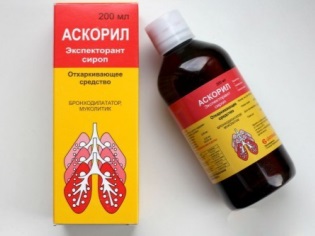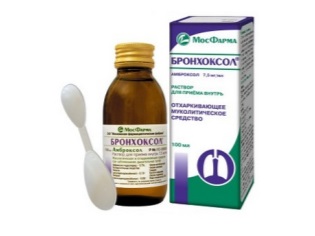Syrup "Ambrobene" for children: instructions for use
If a child suffers from coughing, mucolytics are often prescribed. One of the popular drugs of this group can be called Ambrobene. For children, this tool is produced in the form of a tasty syrup. What dosage can be given to babies and how to take such medicine correctly?
Release form
Ambrobene in syrup is a clear solution that may be both colorless and slightly yellowish. This raspberry syrup smells, and in one bottle it contains 100 ml.
In addition to the syrup, the drug called Ambrobene is represented by other forms:
- Pills.
- SolutionWhich drink, and also apply to inhalations.
- Solution for injections into the vein.
- Long acting capsules.
Composition
In Ambrobene, Ambroxol Hydrochloride serves as a therapeutic agent. This compound for every 5 ml of syrup contains 15 mg.
Additional ingredients due to which the drug remains liquid and does not deteriorate are water, propylene glycol and liquid sorbitol. For a sweet taste and pleasant aroma, saccharin and raspberry flavoring were also added to the preparation.
Operating principle
The main action of Ambrobene in syrup is mucolytic and expectorant.
Taking this medicine:
- Reduces the viscosity of sputum.
- It activates the cells of the mucous membrane of the bronchial tree, thanks to which the secret is secreted in greater quantities.
- Stimulates ciliated epithelium, which contributes to a more active sputum separation.
- Affects cells whose function is the formation of surfactant.
Drunk drug begins to "work" after 30 minutes, and the duration of the effect of its reception is observed up to 12 hours.
Indications
Ambrobene syrup is in demand for various respiratory diseases. The drug is often prescribed for acute diseases, for example, for bronchitis or pneumonia. It is also prescribed for coughing caused by chronic pulmonary pathologies.
From what age can I give?
Ambrobene is used in pediatrics since birth, however, children younger than two years old are given this drug carefully and only after a doctor's prescription.. It is unacceptable to treat children with this remedy for up to a year without consulting a doctor.
Contraindications
The instruction forbids giving Ambrobene to children in case of intolerance of any of its ingredients - both ambroxol and any excipient. Also, due to the presence of carbohydrates in the composition, this form of the drug is not recommended for glucose-galactose malabsorption, isomaltase deficiency, shortage of sucrase, or fructose intolerance. Adult drug is contraindicated in the first months of pregnancy.
If the child has an ulcerative lesion of the gastrointestinal tract, too much sputum, kidney disease, or severe hepatic abnormalities, Ambroxol treatment should be extremely cautious. With such problems, the drug should be prescribed by a doctor, since the little patient will have to adjust the dose or frequency of the medication.
Side effects
Sometimes a child’s body reacts to Ambrobene’s treatment with an allergic reaction, for example, the appearance of pruritus, rash or swelling on the face.
Also, the drug can cause:
- Headache.
- Feeling weak.
- Nausea
- Drying of the oral mucosa.
- Disorders of urine.
- High body temperature.
- Shortness of breath.
- Chair disturbances.
- Nasal discharge.
- Stomach ache.
Due to the presence of sorbitol in some children after taking Ambrobene, a slight laxative effect of such a medicine is noted.
Instructions for use and dosage
Ambrobene syrup is recommended to drink after meals.
For the dosage of this form of the drug is to use a measuring cup, which is sold with a bottle of syrup.
The dose of Ambrobene in syrup depends on the patient's age:
- If the child is under 2 years old, then a single dosage of the medicine will be 2.5 ml, which corresponds to half a measuring glass. The drug is given twice a day, resulting in a daily dosage of 15 mg of ambroxol.
- Children from 2 to 6 years They give the same one-time amount of syrup (2.5 ml), but the drug will be taken three times a day. The daily dose of the active substance will be 22.5 mg.
- A child aged 6-12 years at one time requires a full measuring cup, which holds 5 ml of medication. The frequency of application can be 2 times a day (the child will receive 30 mg of ambroxol every day), and three times a day (the daily dose will be 45 mg of the active substance).
- If the child is 12 years old, Ambrobene treatment is started with 2 measuring glasses at one time (10 ml of syrup). At this dose, the medicine is given three times a day so that the daily dosage of ambroxol is 90 mg. After 2-3 days, the effectiveness is assessed, and if it is sufficient, then they switch to a double intake (the child will receive 60 mg of ambroxol per day). With a low therapeutic effect, the frequency of taking the drug is also reduced to 2 times a day, but a single dose is increased to 20 ml, which corresponds to 4 volumetric glasses.
- Without consultation of the doctor, it is impossible to give Ambrobene to children longer than 5 days. When wet or dry coughing in children, the best way out is to contact a pediatrician, because the task of a specialist is to select the correct dose and determine how long mucolytics should be taken.
In order for Ambrobene to take effect more quickly and be more pronounced, a lot of drinking should be offered to the child during treatment.
Overdose
If a child drinks Ambrobene syrup in a higher dose than recommended, it will not have a toxic effect on his body, but may provoke a dilution of the stool and arousal of the nervous system. With a very high dosage of medication, blood pressure may also decrease, severe nausea or vomiting may occur, and saliva will be intensified.
If an overdose is detected within two hours after taking the syrup, it is recommended to flush the stomach and provoke vomiting. With later detection and deterioration of the general condition of the baby, you need to consult a doctor for symptomatic treatment.
Interaction with other drugs
You should not treat the child at the same time Ambrobene in syrup and any antitussive drugs that affect the cough reflex. This combination can cause stagnation of sputum.
If Ambrobene is prescribed with Cefuroxime or Amoxicillinthen these antibiotics will better penetrate the bronchial secretion. The same interaction was found when assigning Doxycycline or erythromycin.
Terms of sale
Buying Ambrobene syrup at a pharmacy does not require a prescription. On average, the price of one bottle of this medicine is 120 rubles.
Storage conditions and shelf life
In order for Ambrobene syrup to retain its healing properties, its storage temperature should not be more than + 25 ° C. To exclude overdose, the drug must be kept out of the reach of children. If the bottle has not been opened, its shelf life is 5 years, but since the package was opened, Ambrobene should be stored in syrup no longer than a year.
Reviews
Ambrobene syrup receives from parents who have treated cough with this remedy from their children more positive reviews than negative ones.Children tolerate such a drug mostly well, and complaints about side effects are rare. The experience of moms shows that Ambrobene really effectively copes with coughing and improves the excretion of sputum, thanks to which children recover faster. The advantages of the drug also include a pleasant taste, ease of dosing, low cost and storage time.
In the following video, see a review from a doctor about expectorant drugs.
Analogs
Replace Ambrobene capable of any analogue, the active substance in which is ambroxol. This medicine may be Lasolvan, Bronhoksol, Bronchus, Ambrohexal, Flamed or another drug. Also, when coughing, the doctor may recommend other syrups with a similar therapeutic effect, for example, Ascoril, Licorice Syrup, Bronhikum, Herbion, Pectolvan or Althea syrup.




